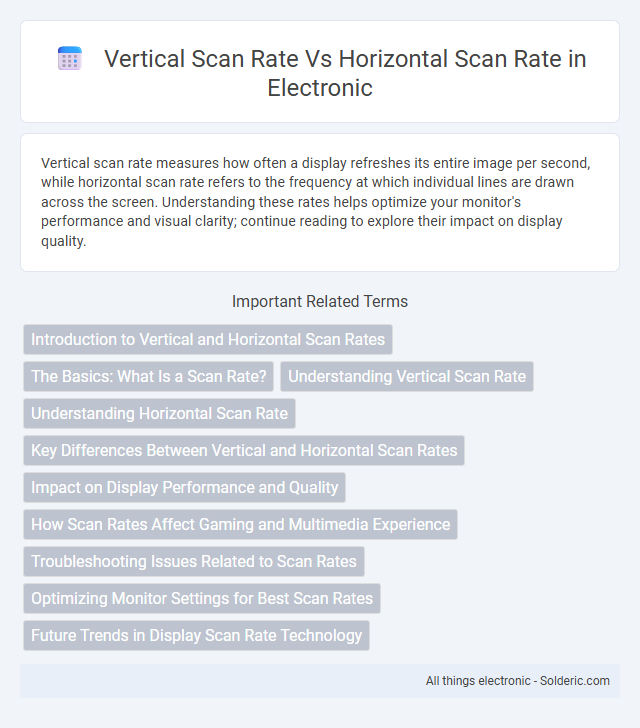Vertical scan rate measures how often a display refreshes its entire image per second, while horizontal scan rate refers to the frequency at which individual lines are drawn across the screen. Understanding these rates helps optimize your monitor's performance and visual clarity; continue reading to explore their impact on display quality.
Comparison Table
| Aspect | Vertical Scan Rate | Horizontal Scan Rate |
|---|---|---|
| Definition | Number of times per second the electron beam refreshes the entire screen vertically. | Number of times per second the electron beam scans each horizontal line across the screen. |
| Measured In | Hertz (Hz) | KiloHertz (kHz) |
| Typical Range | 50 Hz to 240 Hz (for monitors) | 15 kHz to 250 kHz (for monitors) |
| Controls | Determines overall screen refresh rate, impacting motion smoothness. | Determines pixel clock timing and line-by-line scan frequency. |
| Importance | Affects flicker reduction and visual stability. | Affects horizontal resolution and image stability. |
| Relation | Vertical Scan Rate = Horizontal Scan Rate / Total Number of Horizontal Lines | Horizontal Scan Rate = Vertical Scan Rate x Total Number of Horizontal Lines |
Introduction to Vertical and Horizontal Scan Rates
Vertical scan rate refers to the number of times a display refreshes its entire screen per second, measured in Hertz (Hz), crucial for determining how smoothly motion appears on your monitor. Horizontal scan rate measures the number of horizontal lines drawn per second and is key to understanding the monitor's bandwidth and compatibility with different resolutions. Both rates significantly impact display performance, influencing image clarity and flicker reduction.
The Basics: What Is a Scan Rate?
A scan rate refers to the frequency at which a display updates its image, measured in vertical and horizontal dimensions. Vertical scan rate, or refresh rate, indicates how many times per second the entire screen is redrawn, typically expressed in Hertz (Hz). Horizontal scan rate measures the number of individual lines scanned across the display per second, playing a key role in determining resolution and image stability.
Understanding Vertical Scan Rate
Vertical scan rate defines how many times per second your display refreshes the entire screen, directly impacting image smoothness and reducing flicker. Unlike horizontal scan rate, which measures the speed of drawing each line, vertical scan rate determines the overall frame refresh frequency, crucial for visual comfort and performance. Ensuring your monitor's vertical scan rate matches your needs can improve your viewing experience and reduce eye strain.
Understanding Horizontal Scan Rate
Horizontal scan rate measures how many times per second the electron beam scans a single line across the screen in a display. It directly impacts the resolution and refresh capabilities by controlling the speed at which each horizontal line is drawn, typically measured in kilohertz (kHz). Understanding horizontal scan rate helps you optimize display settings for clearer images and smoother motion on CRTs and some LCD monitors.
Key Differences Between Vertical and Horizontal Scan Rates
Vertical scan rate measures how many times per second the entire screen is refreshed, typically expressed in hertz (Hz), directly affecting flicker perception and eye strain. Horizontal scan rate indicates how many individual lines the electron beam draws per second, measured in kilohertz (kHz), determining the monitor's maximum resolution and refresh capabilities. Vertical scan rate depends on the horizontal scan rate and the total number of lines, making them interrelated but functionally distinct parameters in display technology.
Impact on Display Performance and Quality
Vertical scan rate determines how many times the entire screen is refreshed per second, directly affecting motion smoothness and reducing flicker for better display performance. Horizontal scan rate controls how quickly each individual line is drawn, influencing the maximum resolution and sharpness of your display. Optimizing both rates ensures high-quality image rendering and a seamless viewing experience with minimal eye strain.
How Scan Rates Affect Gaming and Multimedia Experience
Vertical scan rate, measured in hertz (Hz), determines the number of times your screen refreshes per second, directly impacting the smoothness of motion in gaming and multimedia. Horizontal scan rate, expressed in kilohertz (kHz), controls the speed at which each line is drawn on the display, affecting the resolution and clarity of fast-moving images. Higher vertical scan rates reduce screen tearing and motion blur, enhancing your visual experience in dynamic content, while optimal horizontal scan rates ensure crisp detail during rapid scene transitions.
Troubleshooting Issues Related to Scan Rates
Troubleshooting issues related to vertical scan rate and horizontal scan rate involves understanding how these frequencies affect display performance and compatibility. A mismatch in the vertical scan rate can cause screen flickering or instability, while incorrect horizontal scan rates may result in distorted images or no display signal. To resolve these problems, adjusting your monitor settings or graphics card output to match the supported scan rates of your display is essential for optimal performance.
Optimizing Monitor Settings for Best Scan Rates
Optimizing monitor settings for the best scan rates requires balancing vertical scan rate, measured in hertz (Hz), with horizontal scan rate, measured in kilohertz (kHz), to ensure smooth and flicker-free display performance. Adjusting the vertical scan rate optimizes refresh rates to reduce eye strain, while fine-tuning the horizontal scan rate aligns with the monitor's pixel clock frequency for precise image rendering. Using the native resolution and matching the monitor's recommended vertical and horizontal scan rates maximizes display clarity and longevity.
Future Trends in Display Scan Rate Technology
Future trends in display scan rate technology emphasize increasing vertical scan rates beyond 240Hz to enhance motion clarity and reduce eye strain in gaming and professional applications. Horizontal scan rate advancements focus on supporting higher resolutions and refresh rates simultaneously, enabling ultra-high-definition displays with smoother visuals. Your experience will benefit from adaptive scan rates that dynamically adjust based on content, optimizing power efficiency and visual performance.
Vertical Scan Rate vs Horizontal Scan Rate Infographic

 solderic.com
solderic.com